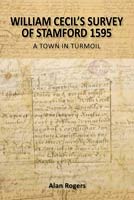In 1595, William Cecil, Lord Burghley, Lord Treasurer of England, commissioned a survey of some of his manors, including Stamford Lordship (the town north of the river) and Stamford Baron (the town south of the river). This survey, from the estate papers of the FitzWilliam family of Milton, now in Northants Record Office, is transcribed in this book, together with some other records of the town from the reign of Elizabeth.
But these papers are prefaced with an account of a series of ‘troubles’ in Stamford in the reign of Elizabeth I - when the followers of Lord Willoughby and of Thomas lord Cecil, older son of Sir William Cecil, fought in the streets; when two parties in the town council quarrelled and dismissed and disenfranchised the other party’s followers from the council and the town; when appointments to the main offices such as Town Clerk and Recorder were passed from hand to hand at the whim of rival groups; when three successive serving Aldermen (mayors) of Stamford were imprisoned by the Privy Council for refusing to obey their commands; when one Alderman mobilised a large contingent of citizens to march on London to try to preserve what they saw as their charter rights and privileges; when William Cecil’s son was accused of riotous behaviour and William Cecil’s chief agent Richard Shute was accused of corruption by William Cecil himself - in short when Lord Burghley’s authority in the town was challenged openly by nobles and lawyers. Yet through it all, William Cecil seems to have acted with moderation, keeping within the law and using the Privy Council rather than his diktat as lord of the manor and town of Stamford. This is a story which has never been told before and which has much to tell us about Stamford, about towns in the sixteenth century, and especially about William Cecil himself - in the year of the five hundredth anniversary of his birth.




